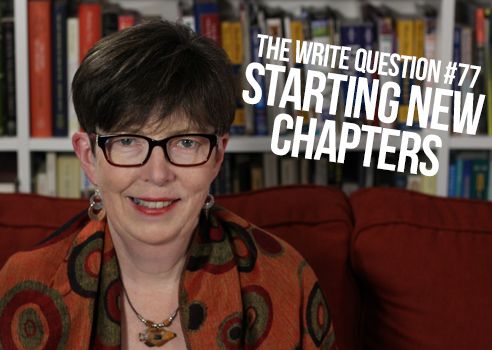Viewing time: 5 mins. 4 secs.
The Write Question is a weekly video podcast about writing that I started in 2017 and that ran, more or less weekly, until April 2022. This is a republication of issue #77, with advice on when to start new chapters in your book. The post first ran on Dec. 14/18.
Transcript:
Welcome to The Write Question, I’m Daphne Gray-Grant and my topic today is when to start a new chapter.
I have a question from Laura White from Edmonton, Alberta. Here’s what’s she’s asked.
“How do you know when to start writing a new chapter for my novel?”
Thanks for your short and succinct question, Laura. First, I want to point out that I’m a non-fiction writer, not a novelist, so you might want to take my advice with a grain of salt. But that said, I’m a really serious reader — I read at least 52 books each year — and I have strong opinions that reflect about 47 years of voracious reading.
If you look at other books, you may have noticed that some writers and/or publishers seem to have loosened the reins a bit. For example, I recently read the book The Rules Do Not Apply by Ariel Levy (link below) and she didn’t seem to have conventional chapters. Instead, she just had chunks of extra space to divide different portions of the book.
Now, I was reading her book on a Kindle, so I have no idea how the printed version looked. It might have been a bit different. I mention this example only to remind you that you don’t need to provide conventionally numbered chapters. Some writers use space, asterisks or other symbolic ‘divisions’ to show they want to reader to see the next bit of text a little bit differently.
On the other hand, if you’re committed to conventional chapters, here’s what I suggest. If your book is going to be 80,000 words, which is considered the ‘average’ for a first novel, you probably want somewhere between 18 and 25 chapters. You don’t need to set them up when you’re writing. Instead, earmark a symbol — it could be a hashtag or an asterisk or even a bunch of XXXXXs— and, as you’re writing, insert it wherever you think you MIGHT be a natural spot for a chapter break.
Then, when you’re editing, you can search for that symbol and decide whether it’s in a good spot and if you want to keep the chapter break there. Be aware that there is no “right” or “wrong” with respect to making chapters. It’s an artistic decision.
So, your next question is probably going to be, when MIGHT be a good spot for a chapter break?
The answer to that kind of depends on the type of book you’re writing. If you’re working on a thriller or mystery, for example, you might want to pick spots of great excitement and end a chapter there.
I’m sure you’ve seen this technique used on television. The final show in a season often has something really exciting happen — a cliff-hanger — and the idea is to keep people so intrigued they’ll be sure to come back next season. Shows like Gray’s Anatomy, Breaking Bad and Mad Men all did this.
But there’s also a literary tradition to cliffhangers. Charles Dickens made the practice popular way back in the mid-nineteenth century when his book The Old Curiosity Shop was published in installments in magazines. He made sure to end each installment with a cliff-hanger. Apparently, in 1841, his fans rioted on the dock of New York Harbor, as they waited for a British ship carrying the next installment. “Is little Nell dead?” they screamed.
Of course, you won’t want to end EVERY chapter this way. But for the right type of book, it can be a very effective technique.
One other method for identifying chapter breaks is to look for changes of place, time or point of view. If, for example, you go from a scene in New York City, to one in Los Angeles, for example, you might want to mark that shift by starting a new chapter.
Similarly, if you’re wanting to present more than one voice, as Barbara Kingsolver does in her book The Poisonwood Bible, you can end a chapter whenever you want to the voice to change. In Kingsolver’s book, link below, the mother narrates the introductory chapter and the narrative then alternates among the four daughters.
Again, let me repeat that making chapters is more of an art than a science so be prepared to experiment, make changes and, most of all, make mistakes.
Finally, let me wrap up with a quote from British-born Canadian writer Matt Hughes: “Many first-time novelists end up rewriting their first two or three chapters, trying to get them ‘just right.’ But the point of the first draft is not to get it right; it’s to get it written — so that you’ll have something to work with.”
Thanks for the question, Laura. Just remember that the objective of your first draft is to get your story on the page. Once you’ve done that, you’ll have the freedom to change the placement of chapters however you like.
Links:
The Rules Do Not Apply by Arial Levy
The Old Curiosity Shop by Charles Dickens
The Poisonwood Bible by Barbara Kingsolver


